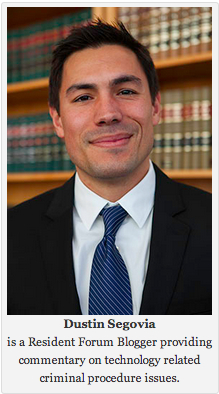The Supreme Court has accepted cert to decide whether, and under what circumstances, police may inspect the contents of a cell phone seized from an individual at the time of arrest. In addressing this issue, U.S. Courts of Appeals have used one of the following three approaches: 1) a bright line rule that precludes searches incident to arrest for cell phones, United States v. Wurie, 728 F.3d 1 (1st Cir. 2013); 2) an opposing bright line rule that allows such searches, United States v. Finley, 477 F.3d 250 (5th Cir. 2007); United States v. Murphy, 552 F.3d 405 (4th Cir. 2009); and 3) a balancing test in which the intrusiveness of the search is weighed against the police interest in executing it, United States v. Flores-Lopez, 670 F.3d 803 (7th Cir. 2012) (J. Posner).
The first approach, a blanket rule permitting a search incident to arrest of cell phones, is arguably too intrusive. At a minimum, it creates the potential for deeply revealing searches irrespective of a legitimate need to search a phone. Moreover, this rule is troubling given that an individual’s cell phone, which may contain a vast array of private and potentially embarrassing information, could be thoroughly examined for any arrest for any crime, even something as minor as a seat-belt violation. SeeAtwater v. City of Lago Vista, 121 S.Ct. 1536 (2001).
The second approach, a blanket rule prohibiting these searches, could weaken law enforcement’s ability to quickly respond to criminal behavior. In Wurie, for example, the defendant received a phone call from a caller identified as “my home” while he was in police custody on suspicion of drug dealing. The police checked the phone’s call log, retrieved the number for “my home,” and located the home associated with that phone number. A warranted search of the home yielded drugs and weapons. Had the officers not been permitted to search the phone, the suspect’s friends, family, or cohorts might have had time to remove the evidence upon learning of his arrest. More pressing examples are conceivable.
The third approach, balancing the intrusiveness of the search against police interest, appears to provide a happy medium between the two extremes, but would require extensive future litigation to delineate permissible police practices. Consider, as an example, that an individual is arrested for misdemeanor possession of marijuana. Would police officers be justified in attempting to ascertain the source of the marijuana by reviewing all incoming and outgoing calls and reading every text message and email sent over the previous day? Week? Month? Would the same arrest allow officers to review every photo or video in the phone for further evidence of possession or other drug related activities? Questions such as these would require a fair amount of litigation to resolve.
Each of the approaches outlined above has its strengths and shortcomings. Reasonable individuals will likely disagree on which approach is best. The most interesting aspect of this case, however, will be the Court’s treatment of cell phones. Over the last several years, the Court’s Fourth Amendment majority opinions have expressed reticence toward the task of balancing privacy and security for new technologies. See e.g. United States v. Jones, 132 S.Ct. 945 (2012); Ontario v. Quon, 130 S.Ct. 2619 (2010). Accordingly, the extent to which the court discusses cell phones, and the manner in which it treats them, could be telling for future Fourth Amendment cases involving phones or new technology generally. Specifically, it will be interesting to see whether the Court believes that a meaningful distinction exists between smart phones and items traditionally recognized as subject to searches incident to arrest, such as cigarette packages, wallets, and briefcases.
For more information, SCOTUSblog has links to the petitions, briefs, and other coverage for both cases that were granted cert: United States v. Wurie and Riley v. California. Argument is set for both cases for Tuesday, April 29, 2014.
Posted March 6, 2014
